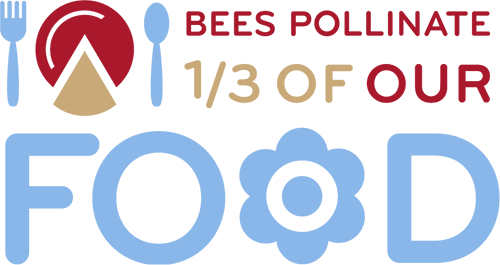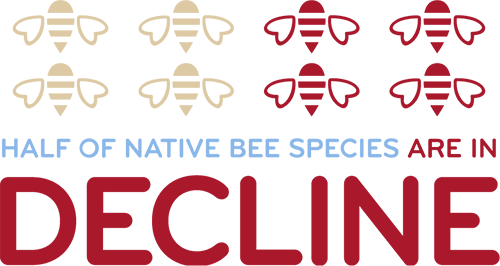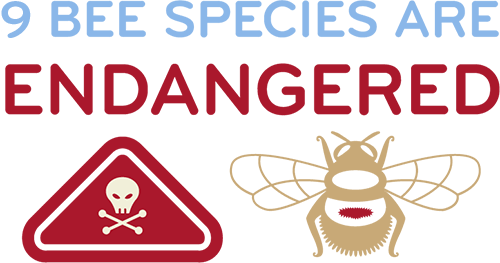


Why Beesponsible?
As the world’s most effective pollinators, bees are responsible for nearly one in three bites of food we eat. Their pollination services also help many of the world’s flowering plants to reproduce, supporting biodiversity and keeping our natural ecosystems healthy. But widespread pesticide use, habitat loss, climate change and parasites threaten bee health and populations. Since 2016, nine native bee species have been declared endangered in the U.S., including the rusty patched bumblebee which was once abundant in over half the country. Learn more below, then take Beesponsible actions to help.
Threats Contributing to Bee Decline

Pesticides And Pollution
Bees exposed to pesticides experience confusion, hindered foraging ability and increased mortality. In particular, neonicotinoids (a certain class of insecticides) pose a toxic threat when absorbed into plants fed upon by bees. Even sublethal amounts of neonicotinoids can be detrimental to bees and other pollinators by disrupting their ability to navigate or forage. Herbicides that eradicate important forage plants for bees and other pollinators also present a threat.
Air pollution contributes to the problem by disrupting bees’ and other pollinators’ natural ability to detect floral scents. When plant-emitted scent molecules interact with air pollutants, the molecules begin to break down. This confuses bees, causing them to spend more time foraging and less time pollinating.
While not as widely recognized, light pollution (brightening of the night sky caused by street lights and other man-made sources) also has a disruptive effect on insect communities and overall ecosystem balance. Research has shown that artificial light at night has a direct impact on the growth, flowering time and yield of plants, which ultimately affects bees and other pollinators. [1]

Habitat Loss
Land development for urban, suburban and agricultural uses, can be detrimental to bees, butterflies and other pollinators. Losing their habitats means pollinators lose the safe places where they nest and overwinter, along with their foraging sources.
Ground-nesting bees need bare, undisturbed dirt to tunnel below and build their nests. In cities, these bees lose their habitats when loose soil is compacted by heavy foot traffic, when landscapes are paved with concrete and when public green spaces are frequently mowed and overly manicured. We must urge our local officials to create more bee-friendly green spaces in communities to attract, shelter and feed bees.
Pollinators’ habitats also decline when they are disconnected from each other by road construction, development or agriculture. Creating safe passages and corridors between such isolated patches of habitats helps pollinators survive in these areas. Roadsides, for instance, are an important yet often overlooked opportunity. Those planted with native grasses and wildflowers — and mowed less often during the growing season — help create refuge and connect fragmented pieces of habitat. Likewise, the practice of planting trees, hedgerows and large strips of wildflowers along field edges also provides more nesting sites and forage sources for pollinators (not to mention the numerous benefits for other wildlife). [2]

Climate Change
The mutually beneficial relationship between plants and pollinators depends largely on phenology (the timing of natural events within plant and animal life cycles). In other words, the time when flowers decide to bloom must match with the time when bees decide to forage. Gradual changes in long-term weather patterns — including temperature, rain and sunlight — can alter environmental cues and disrupt this delicate balance.
For example, warmer-than-usual temperatures affect the time of day certain plant species produce flowers, nectar and pollen. Some bees, on the other hand, may respond by altering the time of day they choose to forage (or limiting their forage distance) to avoid overheating. Unseasonable warmth or increased precipitation may prompt crops to flower earlier in the growing season, before their primary pollinators have emerged.
Bumblebees are among those species who may be most vulnerable to the consequences of a shifting climate. Their range includes higher altitudes and latitude areas where climate change is most dramatic, and the nature of their annual life cycle means their populations show responses to such change more quickly. Findings from a study published in 2017 found that populations of three bumblebee species in Colorado were impacted by indirect effects of climate on flower distribution throughout a season. [3]

Parasites and Diseases
Parasites and diseases pose a serious threat to pollinators. This includes the mite and virus species that have severely compromised honeybee colonies over the past decade. Honeybees’ most dangerous enemy is the varroa mite, which feeds on the blood of adult honeybees and reproduces on honeybee pupae. Varroa mites spread among colonies via drifting workers and drones, along with the robbing of honey from infected hives. Once present in a colony, varroa weaken bee immune systems and transmit a variety of deadly viruses including deformed wing virus.
The mites (and the viruses they transmit) are considered one of several culprits contributing to Colony Collapse Disorder. This occurs when the worker bees disappear from a hive. With no mature bees to bring nectar and pollen back to the queen and younger bees, the colony collapses and dies. Despite certain treatment methods for varroa mites and some diseases, these pervasive threats continue to pose a major challenge to beekeepers and honeybee populations.

Make a Statement for Bees
Spark meaningful conversations about bees when you wear this exclusive Don’t Kill My Buzz t-shirt. Available in unisex and cropped styles.